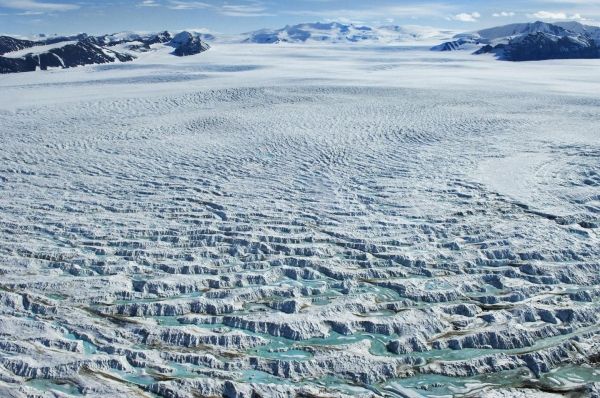An international team of scientists has shown how much sea level would rise if Larsen C and George VI, two Antarctic ice shelves at risk of collapse, were to break up. While Larsen C has received much attention due to the break-away of a trillion-tonne iceberg from it last summer, its collapse would contribute only a few millimetres to sea-level rise. The break-up of the smaller George VI Ice Shelf would have a much larger impact. The research is published today in the European Geosciences Union journal The Cryosphere.
Recent, rapid warming in the Antarctic Peninsula is a threat to ice shelves in the region, with Larsen C and George VI considered to have the highest risk of collapse. Because these large ice platforms hold back inland glaciers, the ice carried by these glaciers can flow faster into the sea when the ice shelves collapse, which contributes to sea-level rise. The new study shows that a collapse of Larsen C would result in inland ice discharging about 4 mm to sea level, while the response of glaciers to George VI collapse could contribute over five times more to global sea levels, around 22 mm.
“These numbers, while not enormous in themselves, are only one part of a larger sea-level budget including loss from other glaciers around the world and from the Greenland, East and West Antarctic ice sheets. Taken together with these other sources, the impacts could be significant to island nations and coastal populations,” explains study-author Nicholas Barrand, a glaciologist at the University of Birmingham in the UK. He adds: “The Antarctic Peninsula may be seen as a bellwether for changes in the much larger East and West Antarctic ice sheets as climate warming extends south.”
Warming in the Antarctic Peninsula led, in 2002, to the dramatic collapse of Larsen B, an ice shelf just north of Larsen C. Unprecedented in its size, almost the entire ice shelf broke up in just over two weeks after being stable for the last 10,000 years.
Read more at European Geosciences Union
Image: George VI Ice Shelf, occupying the sound between the English coast of the southern Antarctic Peninsula and Alexander Island. This study highlights the importance of this ice shelf for regulating the flow of inland ice in the southern peninsula, and therefore for global sea-level rise. (Credit: British Antarctic Survey)


